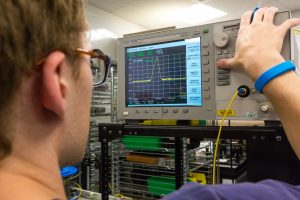
“The fact that we have these well-equipped facilities for use by both students taking courses in person and those who are studying remotely is a real point of pride for our program,” says Ramsey Hourani, program coordinator for Electrical and Computer Engineering. “Recently, one of my students expressed that the reason he chose our online program is that it would allow him to utilize hardware components for achieving a full learning experience.”
Five of those labs—the Human Robotics Interaction Lab; the 3D Printer Lab; the Microwave Electronics Laboratory; the Advanced Communications Laboratory; and the Remote Laboratory—moved to APL last July from the Dorsey Center. (The Digital Electronics Laboratory remains in its original location at APL’s Kossiakoff Center.)
Work in these laboratories is “built-into” the ECE program curriculum as assignments, both for students studying onsite and remotely, Hourani says.
“The labs allow students real, hands-on design experience from instructors who are experts in the subject matter,” he explains. “Practical engineering problems are presented and evaluated throughout the course using state-of-the-art test equipment that prepares students for addressing the latest technological advances in electrical and computer engineering.”
The Human Robotics Interaction lab provides students the ability to investigate human-robot interaction and prosthetic control, while the Microwave and Electronics Lab and the Advanced Communication Lab are facilities that allow students to design, develop and test microwave components and communication circuits. They house a full variety of microwave testing and measurement equipment, including network and spectrum analyzers; noise-measuring equipment; function generators; and synthesizers. The 3D Printer Lab allows rapid design prototyping, and the Digital Electronics Lab lets students develop and test digital systems for hardware/software codesign, such as software-defined radios.
While these laboratories are currently focused on students who attend classes onsite, EP is working on ways to increase remote students’ access to them, as well. (In some courses, hardware and “labs-in-a-box” are mailed to the students as part of their classwork.) The Remote Lab is specifically designed so that students who are taking the program online can have access to state-of-the-art instrumentation, including oscilloscopes, spectrum analyzers, power supplies, and function generators, via the internet.
“Students can log into the remote lab any time during the week to complete their lab assignments. It is very convenient and handy,” Hourani says.